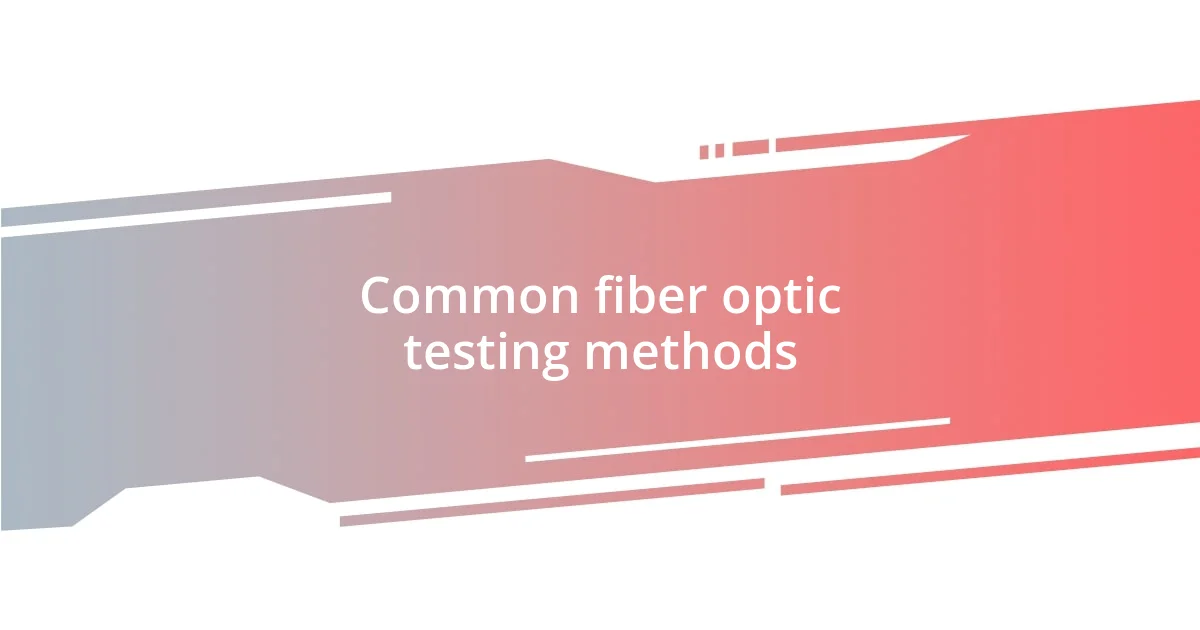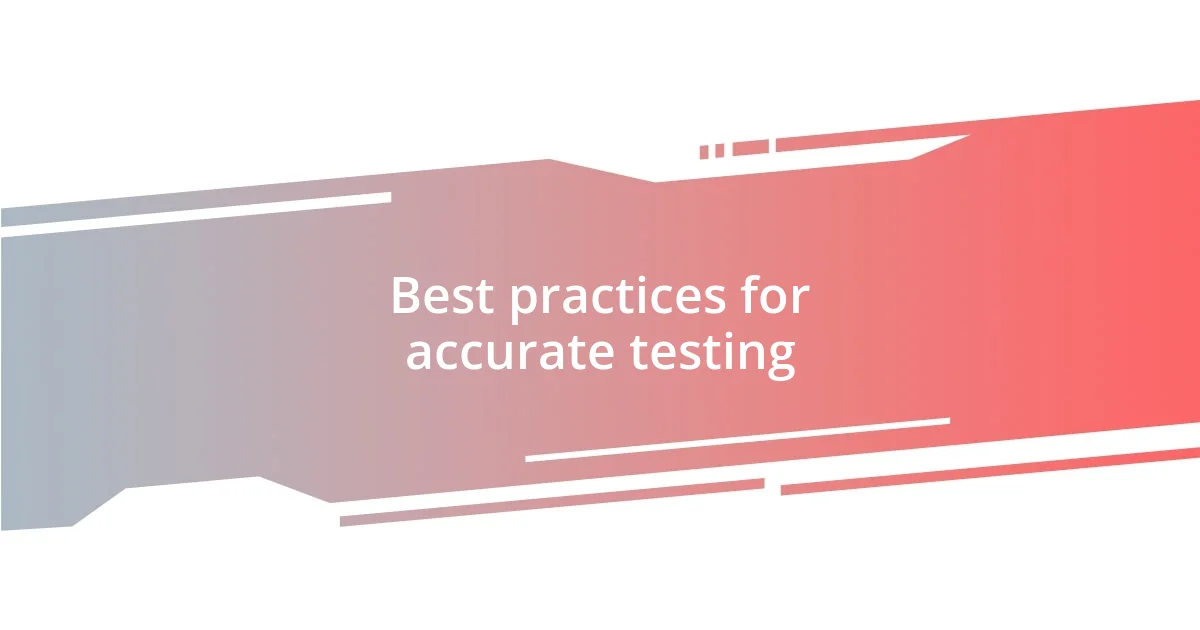Key takeaways:
- Fiber optics enables high-speed data transmission through light signals carried in glass strands, revolutionizing communication.
- Testing fiber optic networks is crucial for reliability, identifying potential issues, and enhancing performance to prevent data loss.
- Best practices for accurate testing include proper calibration, maintaining cleanliness, and thorough documentation to ensure reliable results.

Understanding fiber optic basics
Fiber optics is fundamentally about transmitting data using light signals, which is both fascinating and transformative. When I first delved into this field, I was amazed by how light could travel through glass strands, transforming our communication landscape. Have you ever wondered how the internet can be so fast? It’s largely because of these incredibly thin fibers that can carry vast amounts of information over long distances with minimal loss.
Understanding the core components of fiber optics—like the core, cladding, and protective coating—really enhances your grasp of how it all works. I remember the first time I held a fiber optic cable and marveled at its flexibility. It made me appreciate the delicate balance between durability and functionality. Each element plays a crucial role in ensuring that light signals remain intact from point A to point B.
As I explored fiber optics further, I found myself reflecting on its potential. The sheer power of fiber optics in supporting high-speed internet, video streaming, and telecommunications is something that can’t be overstated. It’s exciting to think about how this technology has brought the world closer together. Have you felt that rush of connectivity when your video call goes seamlessly? That’s the magic of fiber optics at work.

Importance of fiber optic testing
When I first started testing fiber optic networks, the importance of this process hit me like a light bulb going off. I realized that testing isn’t just about checking for glitches; it’s about ensuring reliability and efficiency in communication. One misalignment or tiny defect can cause data loss or slowdowns that impact everything from business operations to personal communications. The thrill of knowing that I could play a part in maintaining these connections was truly fulfilling.
- It ensures quality and reliability of data transmission.
- Helps in identifying potential issues before they escalate.
- Enhances the overall performance of communication networks.
- Supports compliance with industry standards.
- Fosters trust between service providers and customers.
Throughout my testing experiences, I’ve witnessed firsthand how critical it is to take this step seriously. I recall a project where a simple oversight almost resulted in a setback for a client’s major event. Thanks to diligent testing, we caught the problem beforehand. That moment solidified my belief in the practice and underscored its vital role in keeping our increasingly connected world running smoothly.

Common fiber optic testing methods
Understanding different fiber optic testing methods is essential for anyone involved in ensuring the quality of communication networks. At the core of fiber optic testing, we commonly use techniques like Optical Time Domain Reflectometer (OTDR), which essentially sends pulse signals down the fiber and measures what comes back. I remember the first time I operated an OTDR; it felt like peering into the very fiber itself, revealing hidden mysteries in the network that I could fix before they turned into larger issues.
Another popular method is the use of a Light Source and Power Meter, which measures how much light is transmitted through the fiber. This approach is straightforward and incredibly effective. On one occasion, while installing a new setup in a downtown office building, we were able to pinpoint a loss of signal within minutes. It was both exhilarating and reassuring to see the data on the meter and know we were immediately addressing what could have been a significant problem down the road.
In some cases, an Inspection Microscope is employed to analyze the end faces of the fiber connectors. Ensuring these surfaces are clean can make all the difference in maintaining signal integrity, as I learned during a testing session where a simple speck of dust caused major connection issues. This hands-on experience highlighted not just the technical aspects of testing but also the personal satisfaction that comes from troubleshooting—transforming challenges into solutions that enhance communication efficiency.
| Testing Method | Description |
|---|---|
| OTDR | Sends pulse light through fiber, analyzes reflections to diagnose issues. |
| Light Source and Power Meter | Directly measures light transmitted, revealing signal loss. |
| Inspection Microscope | Examines fiber connector surfaces to ensure cleanliness and integrity. |

Interpreting fiber optic test results
Interpreting fiber optic test results can be a nuanced process that requires both technical knowledge and intuition. I remember reviewing the first OTDR printout I encountered—at first glance, it seemed like a jumble of lines and numbers. However, after some study, I learned to read the graphical signatures, recognizing that dips indicated potential faults. The adrenaline rush of identifying issues before they caused disruptions was a rewarding experience.
When I analyze results from a Light Source and Power Meter, I always look for small variations in readings. It never ceases to amaze me how a subtle drop in light transmission can signify a hidden problem, like a bend in the fiber or a faulty connector. I vividly recall a time when we were troubleshooting a persistent issue; initially, the readings seemed normal. Then, I spotted a slight anomaly that led us to a connector needing replacement—it was like being a detective piecing together clues!
Don’t overlook the importance of context when interpreting results. A fiber link that shows minimal loss might still be underperforming due to external factors, like environmental conditions or installation errors. I often find myself questioning whether the setup was optimized based on test outcomes. This mindset not only enhances my understanding but also fosters a proactive approach in troubleshooting—ensuring that I’m not just reacting to data, but actively seeking to improve network performance.

Best practices for accurate testing
To achieve accurate testing in fiber optics, proper preparation is key. I always ensure that my testing equipment is calibrated before starting any job. I once neglected this during an initial setup, thinking everything was fine since the gear had been used recently. Yet, the inconsistencies in results that followed taught me the hard way—never skip calibration, as it sets the foundation for reliable data.
Another crucial practice is maintaining a clean testing environment. I vividly recall a day when I was at a client’s site and noticed smudges on my fiber connectors. It only took a few quick wipes for things to improve significantly. It’s astounding how much a sterile working area affects outcomes; it’s something I now prioritize before any testing session. Have you ever considered how a little dust could disrupt an entire network? It’s a quick yet impactful change that I’ve seen save hours of troubleshooting.
Documentation is another best practice that cannot be overlooked. After every testing session, I jot down observations and results meticulously. I still remember the time I ignored this step, thinking I would remember everything. I couldn’t recall key details days later, leading to unnecessary rework. Keeping track not only helps me, but it also provides clarity for future tests. Why risk losing valuable insights when a simple note could prevent headaches down the line?

Real world applications and benefits
Working with fiber optics brings numerous real-world applications and benefits that can significantly enhance network performance. For instance, I once collaborated on a project that required high-speed data transmission between multiple buildings in a university campus. By implementing fiber optic technology, we reduced latency and boosted bandwidth, ultimately enriching the educational experience for thousands of students. Isn’t it incredible how something as simple as light can transform communication?
I also appreciate the reliability that fiber optics offer, especially in demanding environments. I recall a challenging installation for a citywide surveillance system, where the stakes were incredibly high. By utilizing fiber optics, we achieved seamless video streaming without interruptions, allowing authorities to monitor the city more effectively. The sense of pride I felt knowing that our work directly enhanced public safety was truly rewarding. Have you ever thought about how integral these applications are in our daily lives?
The longevity of fiber optic systems is another noteworthy benefit. During my experience, I’ve seen installations designed to last decades without significant degradation in performance. I remember a client who expressed initial skepticism about investing in fiber optics, worried about the costs. However, after discussing the reduced maintenance requirements and lifespan, they leaped at the opportunity. How often do we overlook long-term savings for short-term costs? In this case, it certainly paid off, proving that fiber optics are not just a trend but a sustainable solution for the future.















